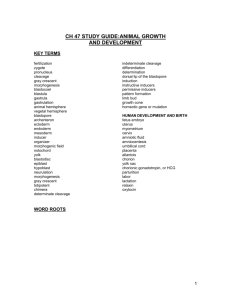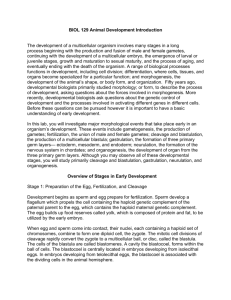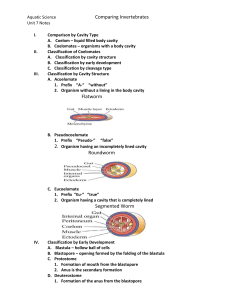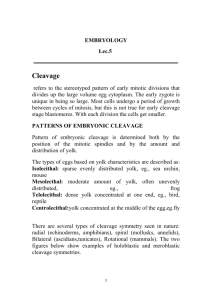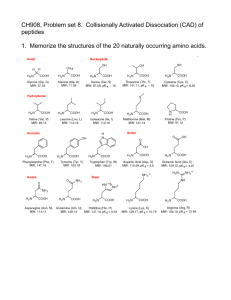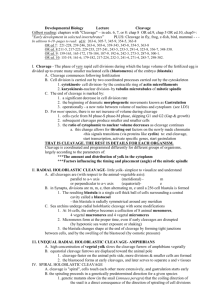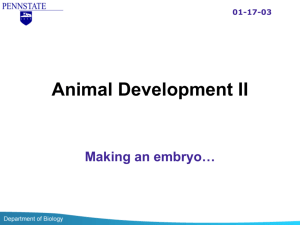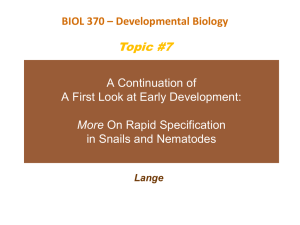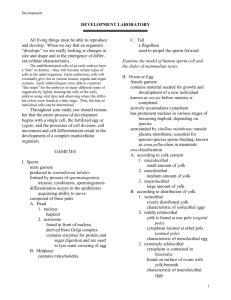16. Early Embryo Develop 2010
advertisement
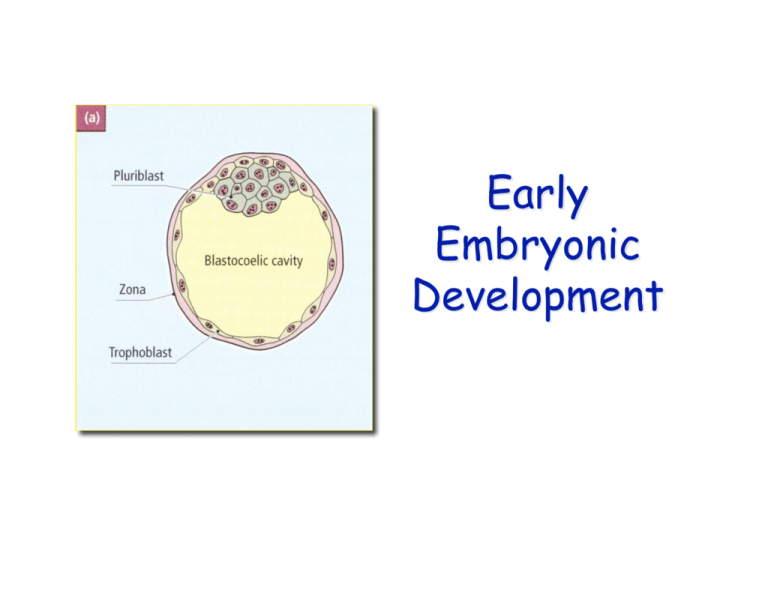
Early Embryonic Development Zygote - Embryo • two gametes fuse to produce zygote • with first division embryo is produced Cleavage A series of mitotic divisions whereby a multicellular organism is formed – Cells produced are called blastomeres – Controlled by maternal mRNA and protein in most species – Most species = no net gain in volume • allows rapid division • is accomplished by skipping the G1 and G2 growth period between mitotic divisions Mitosis Promoting Factor • Regulates biphasic cycle of early blastomeres • Made up of two subunits – Cyclin B: accumulates during S phase and degrades following M phase – Cyclin-dependent kinase (cdc2): phosphorylates key proteins involved w/ mitosis Cleavage • Rapid exponential increase in cell # – Frog egg divides into 37,000 cells in 43 hrs • 1 cleavage/hr – Drosophilia-50,000 cells in 12 hrs • 1 division every 10 mins for 2 hrs • Initially synchronous until mid-blastula transition – Growth phases added – Synchronicity lost – New mRNA transcribed Rate of formation of new cells in the frog Rana pipiens Mechanism of Mitosis • Result of two coordinated processes – Karyokinesis • Mitotic spindle of tubulin microtubules • Draws chromosomes to centrioles – Cytokinesis • Contractile ring of actin microfilaments • Creates cleavage furrow Cleavage Furrow Amount of Yolk in Oocyte • POLYLECITHAL or MEGALETHICAL - large amount of yolk – found in elasmobranchs, teleost fishes, reptiles, birds • MESOLECITHAL - moderate yolk – found in frogs and salamanders • OLIGOLECITHAL OR MICROLECITHAL little or no yolk – echinoderms, cephalochordates (Amphioxus), urochordates (tunicates), prototherian mammals Location/Distribution of yolk • a. CENTROLECITHAL - centrally located – found in arthropods, many insects • b. TELOLECITHAL - at a vegetal pole – these eggs have animal pole with "active" cytoplasm thickened below which lies the maternal pronucleus – thickened regions called BLASTODISC – common in mega- and mesolecithal eggs • c. ISOLECITHAL OR HOMOLECITHAL - yolk evenly distributed – common in oligolecithal eggs – marsupial mammals General Patterns of Cleavage • HOLOBLASTIC CLEAVAGE – complete, equal daughter cells – common in micro- and mesolecithal eggs • MEROBLASTIC OR DISCOIDAL CLEAVAGE – only blastodisc divides – megalecithal eggs For Example Mammals • Oligolecithal Birds -Amount- • Megalecithal • Isolecithal -Distribution- • Telolecithal • Holoblastic -Pattern- • Meroblastic • Rotational -Symmetry- • Discoidal Patterns of Cleavage Cleavage-The Big Picture • Series of cytoplasmic divisions w/out growth • Initially forms a solid mass of cells known as the morula • A fluid-filled cavity forms w/in the morula called the blastocoel • The hollow ball of cells is now known as the blastula Meroblastic radial cleavage in frogs w/ mesolecithal yolk Meroblastic bilateral cleavage in birds w/ telolecithal yolk Χ Pronucleus Ξ Pronucleus Degenerating tail of sperm First and second polar bodies Second polar body B C Cleavage spindle Chromosomes Zygote Breakdown of pronuclear membranes D E Polar body Zona pellucida Blastomere B A 2-cell stage C 8-cell stage 4-cell stage Zona pellucida D Morula Inner cell mass Degenerating zona pellucida Blastocyst cavity E Trophoblast Early blastocyst F Later blastocyst Posterior wall of uterus Blastocysts Morula Eight-cell Four-cell Two-cell stage stage stage Growing follicle Early primary follicle Zygote Fertilization Follicle Secondary approaching maturity Mature follicle follicle Oocyte Oocyte in tube ity Blood vessels Epithelium Corpus albicans Mature corpus luteum Atretic (degenerating) follicle Endometrium Released oocyte Ruptured follicle Connective tissue Coagulated blood Developing corpus luteum Mammals - Humans • Blastula also forms –Inner cell mass = embryo –Trophoblast - placenta Corona radiata Degenerating sperm (composed of follicular cells) Blastomere Zona pellucida Polar body (nonfunctional cell) Polar body Inner cell mass Blastocyst cavity Trophoblast Remnant of zona pellucida
